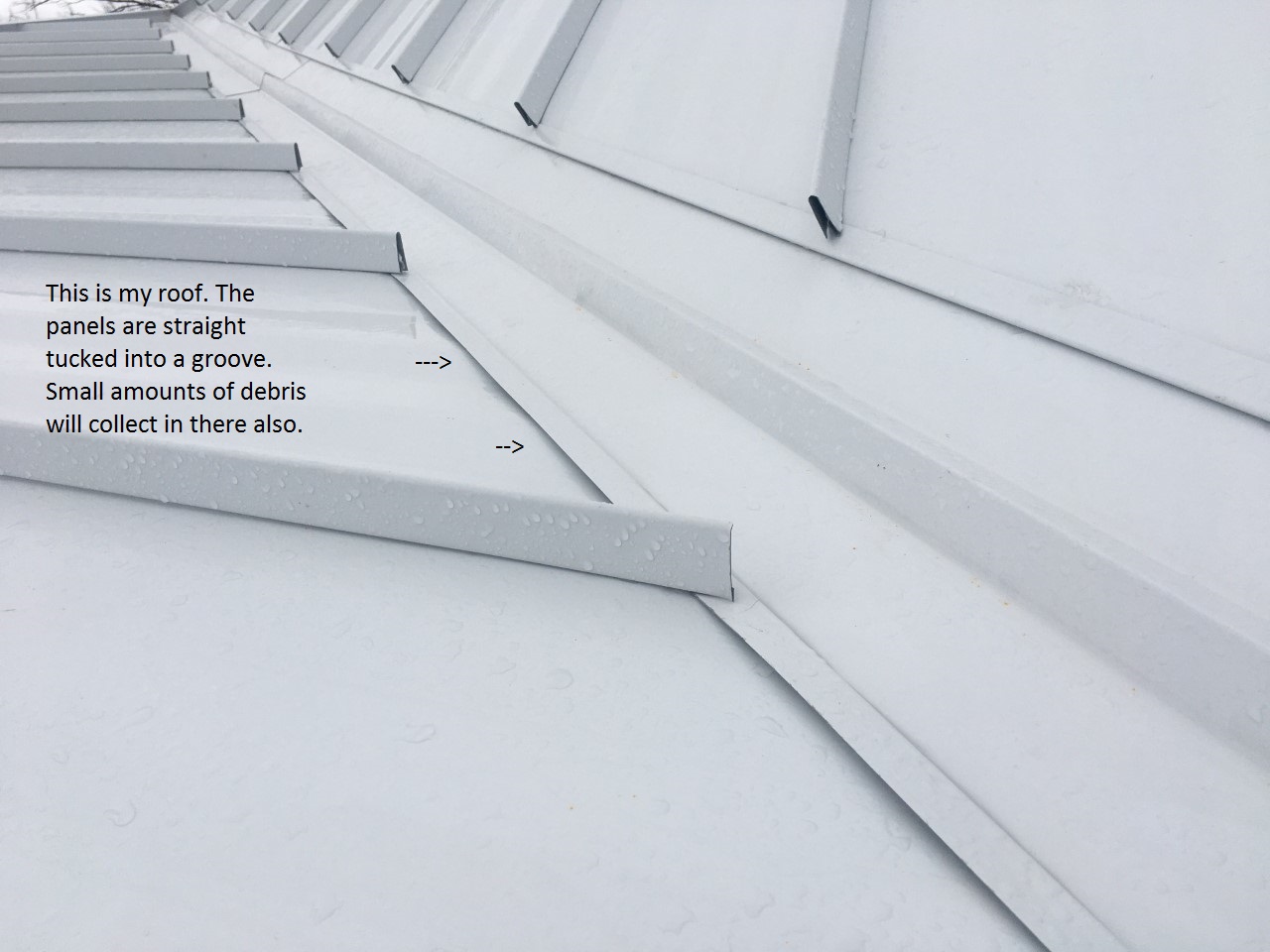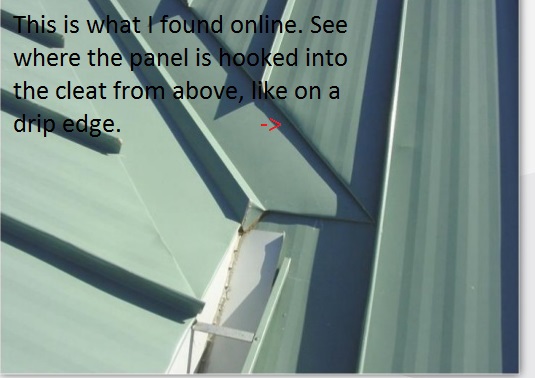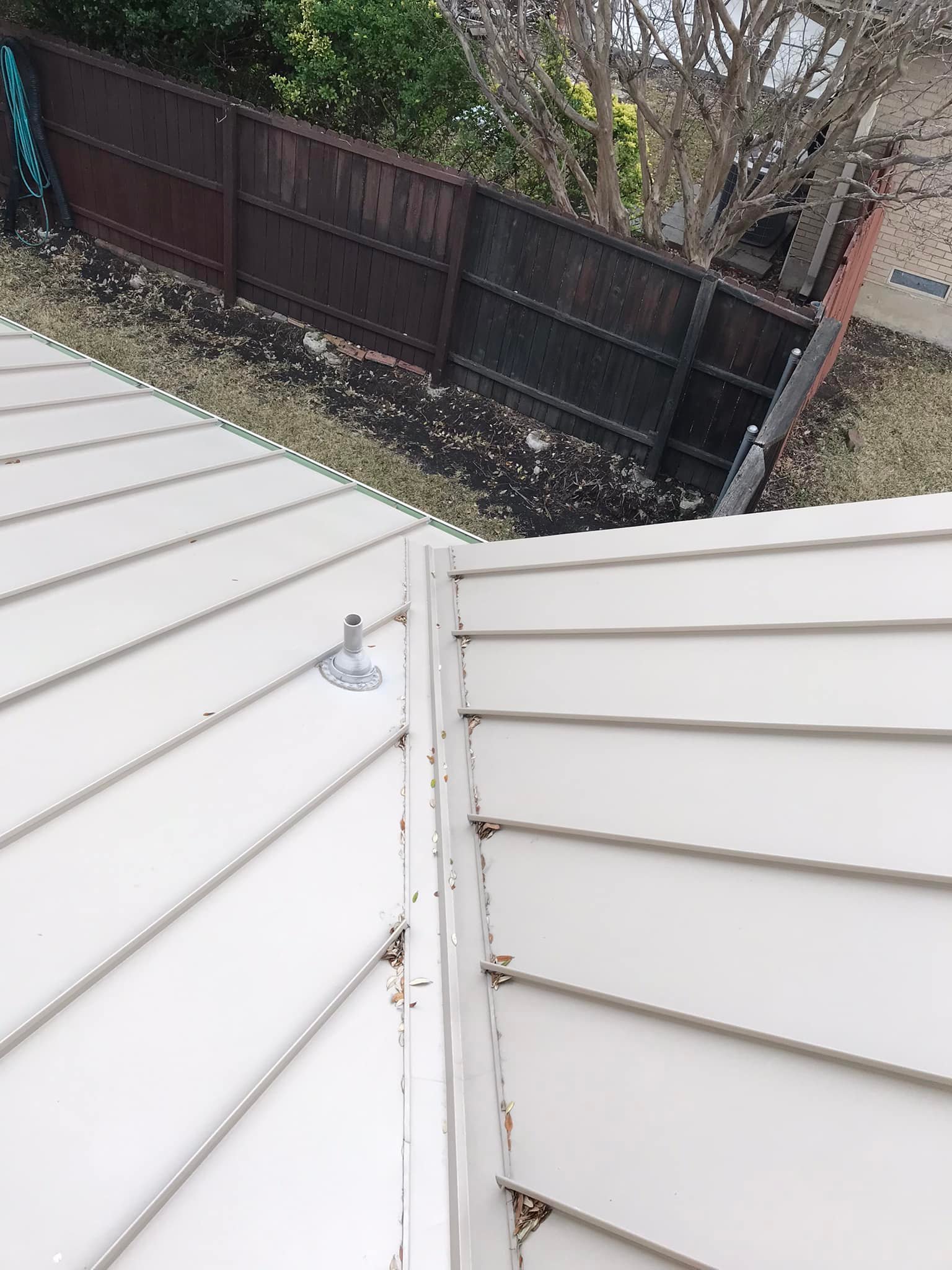If you would like to reply to this thread, please log in. If you do not have an Ask the Experts forum user account, create one here.
If you would like to reply to this thread, please log in. If you do not have an Ask the Experts forum user account, create one here.
I just got an expensive standing seam metal roof installed (24 gauge galvalume with Kynar paint).
After watching some installation videos online from expert installers, I noticed that my valley details are different.
The installers inserted the panel pieces straight into what seems like a little groove installed on top of the valley pan.
What I've seen online is that the standing seam panels get bent over at the end and then tucked into an offset cleat, similar to what is done at the roof bottom, where the panel is hooked into the drip edge.
Maybe what I have is an acceptable installation. I have no clue. The installers seemed knowledgeable and walked me over every detail. It didn't seem like they were in doubt about their methods.

12/13/2020
Or copy this URL: https://www.metalroofing.com/spirit/comment/25278/find/Thank you for choosing metal What was done with your valleys is not typical. I think the concern is whether over time the receiving channels will be able to handle the water, ice, and snow ... and whether they may clog with tree debris, etc. I would suggest talking to the installers and asking them to diagram out the valley and explain how they prevent it from clogging over time. I'd also ask them if this valley is within the scope of installation details recommended by the roofing manufacturer.
Isaiah Industries, Inc.
12/14/2020
Or copy this URL: https://www.metalroofing.com/spirit/comment/25279/find/Thank you, Todd, for your reply. I will ask for that diagram.
I am afraid, though, I got stuck with a non-standard installation. If no manufacturer recommendation exists for this particular style, is it appropriate for me to demand that they redo those areas? Unfortunately, I have four valleys like that. The same channel was used behind my chimney to tie the panels into the flashing pan.
Little ice and snow here in North Texas, but also approx. 42 in of annual rainfall. Trees are all trimmed away, so little debris from that makes it up there.
Still, this seems like a maintenance item. I am more afraid of long term failure, though, as some of the water is carried inside that channel, and not on top of the valley.
12/14/2020
Or copy this URL: https://www.metalroofing.com/spirit/comment/25280/find/I did a test with some water this morning, pouring it directly against the channel. Some spilt over and into the valley (where it all should be), some was directed to the eaves inside the channel. Some traveled alongside the back of the bottom hem of the panels, appearing at the drip edge approx. 30 inches away from the valley. I assume that means water gets somehow redirected under the panels. Even as a layman, this doesn't seem acceptable to me.
12/14/2020
Or copy this URL: https://www.metalroofing.com/spirit/comment/25282/find/It may be that the water is traveling along the starter. I really do not know what to say as this is a valley details I have never before seen done with standing seam. One option might be to go see past, older jobs they have done the same way. My gut feeling does leave me with concerns about long term performance. That said, your weather environment and conditions do sound more supportive of this detail than many other environments and conditions.
Isaiah Industries, Inc.
12/15/2020
Or copy this URL: https://www.metalroofing.com/spirit/comment/25283/find/Hello. I would like to know the outcome. I had a standing seam roof installed summer 2021. I noticed many sloppy procedures and mistakes. My valleys are also crimped over the panels trapping leaves. I would like to see if the homeowner resolved this by having the valleys redone.
3/8/2022
Or copy this URL: https://www.metalroofing.com/spirit/comment/25824/find/Hi, I am the original poster, and to answer your question: I fought a long time with the contractor, and ultimately he agreed to pay for most of the repairs. I had another company remove all valleys and install them anew according to industry standards. It took a long time, involving credit card chargebacks and threats to file a bond claim.
Personally, I would not be happy with what you have. Seems like there is something fundamentally wrong. Those valleys should be unobstructed so that debris can flush out.
3/8/2022
Or copy this URL: https://www.metalroofing.com/spirit/comment/25827/find/I worked with 24 guage snaplock steel panels for 8+ years in Virginia under a guy by the name of Wayne Kidd (bootsie) he passed away last year. He was one of the biggest and best 24 guage metal distributor on the east coast. He owned K&N Gutters Guards and etc. I worked for my stepfather who worked directly for Wayne Kidd, we were Wayne Kidds Metal Crew. My stepfather once did a metal roof for the TV stars who build the tree houseson TV in Virginia at a place called Belarose. That being said my stepfather is one of the best 24 gauge steel metal installers in the state of Virginia and still is he does not advertise all his business is from Word of Mouth he is in his fifties now he has been doing this for over 30 years. Now for the nine-plus years I worked for him we always ran an open Valley Pan with reverse J on each side of the valleys with buttyl tape on the bottom so it seals to the valley pans then we screw all the way up the valley in the reverse J every 3 inches apart we have not had a single leak or damage in a valley ever since my stepfather has been putting metal on and actually in the state of Virginia there's a well-known company called Max Kendall who is a metal distributor and does standard seam metal they're actually switching over to the open Valley himless system because it is a cleaner looking system a easier system to install you don't have to sit there and him each pan to the valley that's just tedious and time consuming and if it is ran right it is a leak proof system
7/30/2022
Or copy this URL: https://www.metalroofing.com/spirit/comment/26010/find/7/30/2022
Or copy this URL: https://www.metalroofing.com/spirit/comment/26011/find/Thanks for your input, Lee. I have seen this valley detail 3 times now in the past year -- the first I'd seen it in 40 years. I understand that one of the manufacturers used to teach this method. I am not sure if they still do. This is certainly not a method I have seen taught by other manufacturers or in any best practices books. I am really glad it's worked for you. To be honest, I am having a tough time accepting it but I always want to learn. Have you seen no issues with leaves or other debris getting stuck in it or even ice and snow causing problems? Are you in a high snow area?
Isaiah Industries, Inc.
7/30/2022
Or copy this URL: https://www.metalroofing.com/spirit/comment/26012/find/My other chief concern is edge rust / edge creep if any moisture gets hung up in the J area over time.
Isaiah Industries, Inc.
7/30/2022
Or copy this URL: https://www.metalroofing.com/spirit/comment/26013/find/No offense, Lee, when someone declares himself or his relative the “best installer” under the sun, I cannot help but wonder what that is supposed to mean. Some sort of authority to defend this poor valley method? Nobody here can verify your claims. They are anecdotal at best.
When my original valleys were replaced with the proper method, the old valleys had already collected tons of dirt between the J channel and the panels.
Best to stick to the industry-approved standards. There is a reason why they exist,
The J channel “method” offers no benefits whatsoever to the homeowner. It only saves time for the contractor. The “cleaner look” argument is nonsense. A properly hemmed panel will look just fine.
7/31/2022
Or copy this URL: https://www.metalroofing.com/spirit/comment/26014/find/